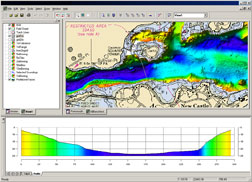| Français | Contact Us | Help | Search | Canada Site | ||||
| About IRAP | Across Canada | Careers | Home | NRC Site | ||||
|
|
|
|||||||||||||||||||||||||||||||||||||
|
|
|
|||||||||||||||||||||||||||||||||||||

|
|
Innovation LeadersCARIS
|
|||||||||||||||||||||||||||||||||||||||||||||||||
 |
| "We approached IRAP because we knew they are very innovative, and the process unfolded from there," |
For centuries, maps have been powerful tools for recording geographic information and finding your way around. But now the efforts of a high tech firm based in Fredericton, New Brunswick, are adding dramatic new dimensions to the venerable capabilities of the map.
CARIS, which employs some 120 people, has spent more than 25 years developing an expertise in several key areas of mapping technology for land and marine applications, as well as using spatial information to meet even more specific needs. Established in 1979, the company has found many growing markets for its software products.
By the late 1990s, CARIS saw Internet-based applications as the next logical direction for its work. Moving into this new line of business represented a significant challenge, one that took staff beyond any previous experience with the necessary development tools. Administrators sought help from the National Research Council Industrial Research Assistance Program (NRC-IRAP), and as a result, their ambitions into a practical reality. NRC-IRAP works closely with small and medium-sized enterprises, helping them grow their businesses, increase their competitiveness, and enhance their impact in the marketplace.
CARIS Spatial Fusion, the internet-mapping software that evolved from the support of NRC-IRAP, makes it possible to display and distribute geographic data on-line, providing new prospects for warehousing this information or manipulating it in real-time. This development established the core data model that would grow the CARIS product line further.
According to CARIS Project Coordinator Mark D'Arcy, the NRC-IRAP was instrumental in providing both technological planning and financial assistance to CARIS that enabled the development of this timely core technology. "Our objective was to re-engineer close to 20 years of development over the next two years. Our design was unique but the technical complexity of the project was daunting and would require the largest development team ever assembled at CARIS," says Mark D'Arcy. "We approached NRC-IRAP and began a very in-depth and cooperative effort between NRC-IRAP Industrial Technology Advisors and CARIS to develop a technological work plan. The final proposal focused on investigating core CARIS technology, the assessment of technological uncertainty and a detailed work plan to mitigate those risks, and very distinct, quantifiable deliverables that the research hoped to achieve." At the end of the two-year project, CARIS successfully completed the prototype of the database-driven solution CARIS HPD (Hydrographic Production Database).
CARIS has commercialized CARIS Spatial Fusion and CARIS Hydrographic Production Database into specialized products for municipalities, ports, harbours, and charting agencies. These innovations have brought CARIS new markets and clients in both the land and marine sectors, together with the ability to offer new innovation to existing clients, both significant factors in the growth of the company.
Through an academic partnering program, Spatial Fusion is fostering teaching and research activities at universities and companies around the world. The University of New Brunswick recently honoured CARIS for its leadership in geomatics education and improving the ability of students to explore the full potential of spatial data.
The present technological expertise and knowledge at CARIS is based on this past experience with pushing the limits of file-based hydrographic database solutions. Through liaisons with the hydrographic community, including the Canadian Hydrographic Service, CARIS developed a deep understanding into the future need and requirements for a new, open database-driven solution. A new CARIS kernel, which contains a common data model for the production of a wide range of hydrographic charting products, would need to be developed; this advancement would provide the foundation for a new generation of database centric CARIS products.
"The evolution of Spatial Fusion within our various CARIS products is allowing the integration of several databases and data services in very innovative ways," says Mr. D'Arcy. "This is allowing CARIS to stay very competitive in the spatial information management marketplace." The advent of Spatial Fusion led to many requests for CARIS to tailor the software to meet the specific needs of prospective clients. By working closely with the business models of such clients, the company is now embracing an entirely new dimension of consulting activity.
For Mark D'Arcy, this outcome is yet another aspect of the momentum that NRC-IRAP lent to his firm. "We approached NRC-IRAP because we knew they are very innovative, and the process unfolded from there," he says.
 |
|
|||||||